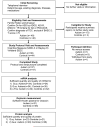Evidence for alterations in stimulatory G proteins and oxytocin levels in children with autism
- PMID: 24485488
- PMCID: PMC4259400
- DOI: 10.1016/j.psyneuen.2013.11.014
Evidence for alterations in stimulatory G proteins and oxytocin levels in children with autism
Abstract
The neurotransmitter oxytocin plays an important role in social affiliation. Low oxytocin levels and defects in the oxytocin receptor have been reported in childhood autism. However, little is known about oxytocin's post-receptor signaling pathways in autism. Oxytocin signals via stimulatory and inhibitory G proteins. c-fos mRNA expression has been used as a marker of OT signaling as well as of G protein signaling. Herein, we hypothesized that oxytocin and its signaling pathways would be altered in children with autism. We measured plasma oxytocin levels by ELISA, G-protein and c-fos mRNA by PCR, and G proteins by immunoblot in cultured peripheral blood mononuclear cells (PBMCs) in children with autism and in age-matched controls. Males with autism displayed elevated oxytocin levels compared to controls (p<0.05). Children with autism displayed significantly higher mRNA for stimulatory G proteins compared to controls (p<0.05). Oxytocin levels correlated strongly positively with c-fos mRNA levels, but only in control participants (p<0.01). Oxytocin, G-protein, and c-fos mRNA levels correlated inversely with measures of social and emotional behaviors, but only in control participants. These data suggest that children with autism may exhibit a dysregulation in oxytocin and/or its signaling pathways.
Keywords: ADI-R; ADOS; Autism; Autism in early childhood; G protein; Oxytocin; Signaling.
Copyright © 2013. Published by Elsevier Ltd.
Figures



Similar articles
-
Cumulative Risk of the Oxytocin Receptor Gene Interacts with Prenatal Exposure to Oxytocin Receptor Antagonist to Predict Children's Social Communication Development.Autism Res. 2019 Jul;12(7):1087-1100. doi: 10.1002/aur.2111. Epub 2019 Apr 26. Autism Res. 2019. PMID: 31025834
-
Plasma oxytocin levels in autistic children.Biol Psychiatry. 1998 Feb 15;43(4):270-7. doi: 10.1016/s0006-3223(97)00439-3. Biol Psychiatry. 1998. PMID: 9513736 Clinical Trial.
-
At the Head and Heart of Oxytocin's Stress-Regulatory Neural and Cardiac Effects: A Chronic Administration RCT in Children with Autism.Psychother Psychosom. 2023;92(5):315-328. doi: 10.1159/000534114. Epub 2023 Oct 11. Psychother Psychosom. 2023. PMID: 37820592 Clinical Trial.
-
Function and structure in social brain regions can link oxytocin-receptor genes with autistic social behavior.Brain Dev. 2013 Feb;35(2):111-8. doi: 10.1016/j.braindev.2012.08.010. Epub 2012 Sep 15. Brain Dev. 2013. PMID: 22986294 Review.
-
[Oxytocin in the treatment of the social deficits associated to autism spectrum disorders].Rev Neurol. 2015 Nov 1;61(9):421-8. Rev Neurol. 2015. PMID: 26503318 Review. Spanish.
Cited by
-
Differences in oxytocin and vasopressin levels in individuals suffering from the autism spectrum disorders vs general population - a systematic review.Neuropsychiatr Dis Treat. 2019 Sep 10;15:2613-2620. doi: 10.2147/NDT.S207580. eCollection 2019. Neuropsychiatr Dis Treat. 2019. PMID: 31571878 Free PMC article.
-
Attenuated relationship between salivary oxytocin levels and attention to social information in adolescents and adults with autism spectrum disorder: a comparative study.Ann Gen Psychiatry. 2020 Jun 5;19:38. doi: 10.1186/s12991-020-00287-2. eCollection 2020. Ann Gen Psychiatry. 2020. PMID: 32518579 Free PMC article.
-
Cross-disorder comparative analysis of comorbid conditions reveals novel autism candidate genes.BMC Genomics. 2017 Apr 20;18(1):315. doi: 10.1186/s12864-017-3667-9. BMC Genomics. 2017. PMID: 28427329 Free PMC article.
-
MAPK3 at the Autism-Linked Human 16p11.2 Locus Influences Precise Synaptic Target Selection at Drosophila Larval Neuromuscular Junctions.Mol Cells. 2017 Feb;40(2):151-161. doi: 10.14348/molcells.2017.2307. Epub 2017 Feb 15. Mol Cells. 2017. PMID: 28196412 Free PMC article.
-
Psychopathy to Altruism: Neurobiology of the Selfish-Selfless Spectrum.Front Psychol. 2018 Apr 19;9:575. doi: 10.3389/fpsyg.2018.00575. eCollection 2018. Front Psychol. 2018. PMID: 29725317 Free PMC article. Review.
References
-
- Al-Ayadhi LY. Altered oxytocin and vasopressin levels in autistic children in Central Saudi Arabia. Neurosciences (Riyadh) 2005;10:47–50. - PubMed
-
- Alfven G. Plasma oxytocin in children with recurrent abdominal pain. J Pediatr Gastroenterol Nutr. 2004;38:513–7. - PubMed
-
- Alfven G, de la Torre B, Uvnas-Moberg K. Depressed concentrations of oxytocin and cortisol in children with recurrent abdominal pain of non-organic origin. Acta Paediatr. 1994;83:1076–80. - PubMed
-
- American Psychiatric Association . Diagnostic and Statistical Manual of Mental Disorders. Fourth Edition. Washington D.C.: 2000. Text Revision.
Publication types
MeSH terms
Substances
Grants and funding
LinkOut - more resources
Full Text Sources
Other Literature Sources

